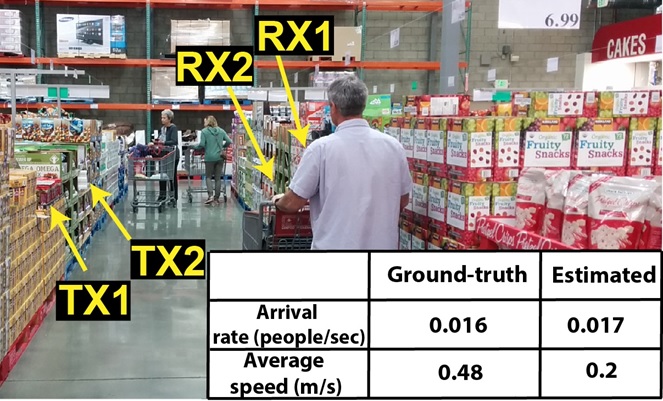
Estimating Occupancy Attributes with Everyday Communication Signals
Saandeep Depatla and Yasamin Mostofi, UCSB
|
|
|

|
| Video on head counting with only a WiFi link, without relying on people to carry a device [JSAC 15] | Video on the first demonstration of crowd counting through walls with WiFi: a WiFi link can count 20 people in this area from behind the walls, using our proposed approach [PerCom 18][project page] | Joint crowd counting and crowd speed estimation with WiFi -- Crowd analytic over whole retail store with minimal WiFi sensing[Secon 18][Secon 19] |
In the News (2015): Gizmag, Huffington Post UK, PC World, ACM Tech News, Gizmodo, Science Daily, International Business Times UK, Tech Radar, Tech Times, Popular Mechanics, Phys.org, RT, UCSB press release, and other outlets
In the News (2018): Tech Crunch, Digit, New Atlas, The Register, Science Daily, UCSB Current, and other outlets
WiFi signals are everywhere these days. So how much information do they carry about us? For instance, can a WiFi link count the number of people walking in an area, without them carrying any device? Can this be done with only WiFi power measurements? Can a WiFi link count people through walls? Can everyday communication signals estimate other attributes of occupancy, such as speed of a crowd, their spatial density, or arrival/departure rate into/out of an area?
In this work, we are interested in answering these questions and developing a foundation for estimating occupancy attributes with everyday communication signals. More specifically, in JSAC 15, we have shown how the total number of people in an area can be counted passively, and by only using the received power measurements of a WiFi link (JSAC 15, video, project page). Our approach is based on deriving a mathematical expression for the probability of crossing the link, as a function of the total number of people, and showing how it is sensitive to the total number of people in the area, thus allowing us to estimate it robustly with only received power measurements. See the project page for more details.
In Percom 2018 (video,project page,paper), we have shown how the total number of people in an area can be counted from behind the walls. The key observation of the paper is that the inter-event times, corresponding to the dip events of the received signal, are fairly robust to the attenuation through walls. We then propose a methodology that can extract the total number of people from the inter-event times. More specifically, we first show how to characterize the wireless received power measurements as a superposition of renewal-type processes. By borrowing theories from the renewal-process literature, we then show how the probability mass function of the inter-event times carries vital information on the number of people. We validate our framework with 44 experiments in five different areas on our campus (3 classrooms, a conference room, and a hallway), using only one WiFi transmitter and receiver installed outside of the building, and for up to and including 20 people. See the project page for more details.
In Secon 2018, we have shown how joint crowd speed estimation and crowd counting (or equivalently rate of arrival estimation) can be achieved with WiFi, without relying on people to carry a device. Our proposed approach is based on the mathematical analysis of the cross correlation of two WiFi links as well the probability of crossing a link, and is validated with 51 indoor/outdoor experiments, where up to 20 people walk in an area with different possible speeds. The framework is also validated in Costco. In Secon 2019, We have further shown how a small number of WiFi links, sparsely distributed over space, can estimate occupancy attributes over the whole retails store. TMC 2019 paper shows how WiFi links can assess occupancy dynamics not only in their own coverage regions but also in adjacent areas.
S. Depatla and Y. Mostofi, "Passive Crowd Speed Estimation in Adjacent Regions with Minimal WiFi Sensing," IEEE Transactions on Mobile Computing, June 2019.[pdf][bibtex]
S. Depatla and Y. Mostofi, "Occupancy Analytics in Retail Stores Using Wireless Signals," in proceedings of the IEEE International Conference on Sensing, Communication and Networking (Secon), June 2019.[pdf][bibtex]
S. Depatla and Y. Mostofi, "Crowd Counting Through Walls Using WiFi," in proceedings of the IEEE International Conference on Pervasive Computing and Communications (PerCom), 2018 (acceptance rate: 19.3%).[pdf][video][project page][bibtex]
S. Depatla and Y. Mostofi, "Passive Crowd Speed Estimation and Head Counting Using WiFi," in proceedings of the IEEE International Conference on Sensing, Communication and Networking (Secon), June 2018 (acceptance rate: 23%).[pdf][bibtex]
S. Depatla, A. Muralidharan, and Y. Mostofi, "Occupancy Estimation Using Only WiFi Power Measurements," IEEE Journal on Selected Areas in Communications (JSAC), special issue on Location-Awareness for Radios and Networks, volume 33, issue 7, July 2015.[pdf][bibtex][video][project page]
S. Depatla, A. Muralidharan, and Y. Mostofi, "System and Method of Occupancy Estimation Utilizing Transmitted Signals," patent # 20160294492, 2017.
All the people that walked in our experiments.